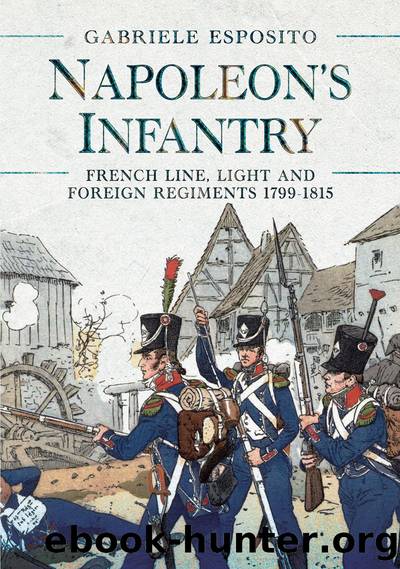Napoleonâs Infantry: French Line, Light and Foreign Regiments 1799-1815 by Gabriele Esposito

Author:Gabriele Esposito [Esposito, Gabriele]
Language: eng
Format: epub
ISBN: 9781399008341
Google: Db5vEAAAQBAJ
Publisher: Pen & Sword
Published: 2022-09-07T21:00:00+00:00
Drummer of the line infantry wearing the 1806 experimental white uniform.
Drum-major of the line infantry with 1812 livery (left) and grenadier of the line infantry with winter campaign dress (right). Note the distinctive corded mace of the drum-major.
Chapter 5
The Light Infantry, 1800â15
Organization
Broadly speaking, during the Napoleonic Period, the line and light regiments of the French infantry performed more or less the same tactical duties on the battlefield, since only the voltigeur companies of both the line and light units were true light infantrymen. The regiments of light infantry were more intensively trained in marksmanship than their line compatriots and were able to execute standard infantry manoeuvres with higher speed, but during large pitched battles they were mostly employed in line or column like the regiments of fusiliers. The chasseurs of the light regiments formed advance guards or scouting parties in front of the line units during marches, and this kind of service could be performed only by soldiers who were intelligent enough to judge the tactical situation independently from the orders received. As a result, in most cases the light infantry regiments had a superior military reputation compared with the line infantry. According to many contemporary observers, no light infantry corps in Europe was able to fight more effectively in open order than the French. More agile and better marksmen than the fusiliers, the chasseurs also proved quite effective when fighting in densely wooded areas or urban centres, where the line infantry usually experienced more difficulties in deploying. Physical fitness and boldness were key factors behind the success of the French light infantrymen, together with the flexibility of their units. Each company of chasseurs could be divided into three small sections when skirmishing. The left and right sections were tasked with firing upon the enemy from covert positions and had the bayonets removed from their muskets in order to be more agile, wheras the centre section was deployed in line, with bayonets fixed, to act as a screen behind which the other two sections could fall for protection in case of need. When skirmishing with the enemy, the French chasseursâ primary targets were officers and artillerymen: the former gave orders to the rank-and-file and thus played a critical role on the battlefield, while the latter were specialized troops and could not be easily replaced with standard infantry. In the Allied armies that fought against France, officers were more important than their French equivalents, since Allied soldiers were largely unable to act independently without orders from their officers like the French did. As a result, killing the officers of an enemy unit meant paralyzing it on the battlefield. Firing at enemy artillerymen also had a great tactical advantage, since killing gunners was much easier than capturing or destroying enemy guns by frontal charge as it could be done from a distance and without losing soldiers.
Download
This site does not store any files on its server. We only index and link to content provided by other sites. Please contact the content providers to delete copyright contents if any and email us, we'll remove relevant links or contents immediately.
What's Done in Darkness by Kayla Perrin(25499)
Shot Through the Heart: DI Grace Fisher 2 by Isabelle Grey(18218)
Shot Through the Heart by Mercy Celeste(18159)
The Fifty Shades Trilogy & Grey by E L James(17773)
The 3rd Cycle of the Betrayed Series Collection: Extremely Controversial Historical Thrillers (Betrayed Series Boxed set) by McCray Carolyn(13188)
The Subtle Art of Not Giving a F*ck by Mark Manson(12903)
Scorched Earth by Nick Kyme(11831)
Stepbrother Stories 2 - 21 Taboo Story Collection (Brother Sister Stepbrother Stepsister Taboo Pseudo Incest Family Virgin Creampie Pregnant Forced Pregnancy Breeding) by Roxi Harding(11036)
Drei Generationen auf dem Jakobsweg by Stein Pia(10216)
Suna by Ziefle Pia(10185)
Scythe by Neal Shusterman(9258)
International Relations from the Global South; Worlds of Difference; First Edition by Arlene B. Tickner & Karen Smith(8607)
Successful Proposal Strategies for Small Businesses: Using Knowledge Management ot Win Govenment, Private Sector, and International Contracts 3rd Edition by Robert Frey(8416)
This is Going to Hurt by Adam Kay(7693)
Dirty Filthy Fix: A Fixed Trilogy Novella by Laurelin Paige(6450)
He Loves Me...KNOT by RC Boldt(5804)
How to Make Love to a Negro Without Getting Tired by Dany LaFerrière(5376)
Interdimensional Brothel by F4U(5302)
Thankful For Her by Alexa Riley(5158)
